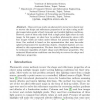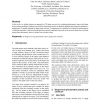142
Voted
PAMI
2011
14 years 8 months ago
2011
—Light occlusions are one of the most significant difficulties of photometric stereo methods. When three or more images are available without occlusion, the local surface orien...
124
Voted
ACCV
2010
Springer
14 years 8 months ago
2010
Springer
Abstract. In this paper we present a novel method to apply photometric stereo on textured dynamic surfaces. We aim at exploiting the high accuracy of photometric stereo and reconst...
135
click to vote
ACCV
2010
Springer
14 years 8 months ago
2010
Springer
We present a new approach to robustly solve photometric stereo problems. We cast the problem of recovering surface normals from multiple lighting conditions as a problem of recover...
101
Voted
COMSIS
2010
14 years 10 months ago
2010
In Photometric stereo, the existence of specularities hampers to recover the normal map. To deal with this common reflective phenomenon, we introduce a novel representation for spe...
127
Voted
PAMI
2007
15 years 17 days ago
2007
Traditional photometric stereo algorithms employ a Lambertian reflectance model with a varying albedo field and involve the appearance of only one object. In this paper, we gene...
106
Voted
CVPR
2008
IEEE
15 years 2 months ago
2008
IEEE
We present a recursive algorithm for 3D surface reconstruction based on Photometric Stereo in the presence of highlights, and self and cast shadows. We assume that the surface re�...
123
Voted
MVA
1994
15 years 2 months ago
1994
The idea of photometric stereo is to serially vary the direction of incident illumination on the state of the holded view point, but it can locally reconstruct only the front surf...
153
Voted
CVPR
2005
IEEE
15 years 3 months ago
2005
IEEE
We address the normal reconstruction problem by photometric stereo using a uniform and dense set of photometric images captured at fixed viewpoint. Our method is robust to spurio...
138
Voted
ECCV
2006
Springer
15 years 4 months ago
2006
Springer
Many previous works on photometric stereo have shown how to recover the shape and reflectance properties of an object using multiple images taken under a fixed viewpoint and variab...
117
Voted
CAIP
2003
Springer
15 years 6 months ago
2003
Springer
In this work, we further discuss an approach to 3D shape recovery by combining photometric stereo and shape from contours methods. Surfaces recovered by photometric stereo are ali...





